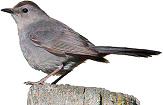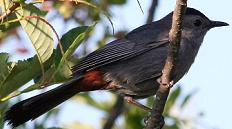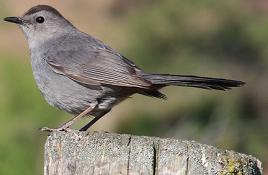Gray Catbird 
Identification and Pictures
(Dumetella carolinensis)
Gray Catbirds are slate gray songbirds 8 to 9
1/4 inches. They have a black cap, dark slender bill,
black legs, and a long black tail. Under tail coverts are
chestnut, and are not often seen. Males, females and juveniles
have similar plumage. They are always flipping their
tail.
Photos by Keith
Lee. The camera I use is the Canon
EOS 40D. Visit All-birds store

Catbirds are known by other names such as, black mockingbird, cat
flycatcher, and black-capped thrush.
Catbird sound
They get their name from the catlike meowing
note they make. Their song is a series of disjointed
notes and phrases. They are good at imitating other
birds such as jays, hawks, quails, and many songbirds.
Catbirds will start singing before dawn, and still be singing
when it gets dark.
Preferred Habitat
Catbirds can be found through Canada, and south
through much of the U.S. Most Catbirds migrate to the
southern U.S., Mexico, and Central America for the
winter. They prefer dense thickets, like the undergrowth
along stream sides, wet, dense-vegetation, and bushes in
bogs. They like bathing, and can often be seen splashing
around the edges of small ponds.
Breeding and Nesting
Catbirds breed from April through
August. Males arrive on the nesting grounds a few days before the females,
and begin singing. During nesting season he will spend
much time singing, and defending his territory from anything
that gets close. During courtship the two birds can be
seen in chases, dashing in and out of shrubbery. The
birds normally mate for life. The nest is cup of twigs,
weeds, leaves, and grass lined with finer material such as
pine needles, and hair. Their nests are usually well
hidden in thick shrubbery. Both birds may gather nesting
material but she will build the nest to her liking. When
he brings material he will give it to her for
construction. The female will incubate 3 to 6 blue-green
eggs for 12 to 15 days. Both parents feed the young birds.
The young leave the nest when in 10 to 15 days, and the parents
will continue to feed them for around 12 days. It is
common for the birds to have more than one brood in a
season. They are often victims of cowbirds, which lay
their eggs in the nests of other birds. Catbirds are
better at detecting the cowbird eggs than many other song
birds, and often eject them.
Food
They eat berries, fruit, seeds, and
insects. They often forage on the ground, flipping leaves
over with their bills for insects such as beetles, caterpillars, grasshoppers,
and ants. They will visit feeders for things like nuts,
and berries.
For more on food
and feeding click here.
To learn about other favorite
birds click here.

|
